
Biography of Munshi Premchand
Munshi Premchand, Hindustani literature (Upanyas Samrat) and Indian writer (novel writer, story writer, and dramatist), was born in the year 1880 on the 31st of July in the Lamhi village (near Varanasi). He is a famous writer of the early 20th century. He left us on the 8th of October in 1936 after serving people his great writings. His birth name was Dhanpat Rai Srivastav and the pen name was Nawab Rai. He wrote his all writings with his pen name. Finally, he changed his name to Munshi Premchand.
Munshi is an honorary prefix given by his lovers in society because of his quality and effective writings. As a Hindi writer, he wrote approximately a dozen novels, 250 short stories, numerous essays, and translations (he translated a number of foreign literary works into the Hindi language).
His Early Life
He spent his childhood in Lamhi in a joint family. He was the 4th child to Ajaib Lal (a post office clerk) and his mother named Anandi Devi (a housewife from Karauni village). His grandfather Sri. Gur Sahai Lal (a patwari means the village accountant) loved him the most. His uncle used to call him Mahabir which means Nawab ( Prince in English) and therefore he chose Nawab Rai as his pen name.
He started his early education at the age of 7 in a madrasa in the Lalpur village (around 2 and a half km away from Lamahi) where he learned Urdu and Persian languages. He lost his mother at the age of 8 because of her illness and later his grandmother too. He felt alone and his father got re-married with his stepmother who later became his recurring theme in his works.
His Early Career
He developed a lot of interest in reading books after his mother’s death that’s why he did the job of bookselling to a book wholesaler to get a chance to read more books. He took admission at a missionary school where he learned English and read the George W. M. Reynolds’s eight-volume named The Mysteries of the Court of London. He was in Gorakhpur when he wrote his first literary writing. He always believed to write about social realism in his Hindi literature and discuss the status of a woman in society.
He got enrolled at the Queen’s College in the Banaras as a day scholar after his father posted to Jamniya in the mid-1890s. He was studying in class 9 when he got married at the age of 15 in the year 1895. The match was arranged by his maternal grandfather. He stopped his studies after his father’s death in the year 1897 because of his long illness. He had started taking tuition to a Banarasi advocate’s son just for 5 rupees per month. Later he got the job of a teacher with a salary of 18 rupees and it was the headmaster of a missionary school in Chunar who helped him to get this job.
In the year 1900, he got a government job as an assistant teacher at the Government District School, Bahraich, and started getting 20 rupees per month as salary. Around 3 years later he was posted to the District School in Pratapgarh. He wrote his first short novel by the title of Asrar e Ma’abid means Devasthan Rahasya in Hindi “The Mystery of God’s Abode”.
His Career
Later he moved to Allahabad from Pratapgarh for the training purpose and afterward posted to Kanpur in the year 1905 where he met the editor of a magazine Mr. Daya Narain Nigam and his magazine was ‘Zamana’ where he published his articles and stories in the later years.
Because of his wife and step-mother’s quarrel, he was unhappy. His wife also tried to commit suicide because his mother used to scold her a lot. Finally, she decided to go her father’s home and never returned. Then Munshiji got married to a child widow named Shivarani Devi in the year 1906 and became a father of two sons named Sripat Rai and Amrit Rai. After his second marriage, he faced several social oppositions. His wife wrote a book on him after his death named Premchand Ghar Mein means Premchand in House.
He published his first story named Duniya Ka Sabse Anmol Ratan in Zamana in the year 1907. In the same year, he published his second short novel named Hamkhurma-o-Hamsavab. Another short novel is Krishna and the stories are Roothi Rani, Soz-e-Watan and etc.
He was poted to Mahoba and then to Hamirpur as a Sub-deputy Inspector of Schools in the year 1909. Around 500 copies of Soz-e-Watan were burnt in a raid of a British collector. This is the reason why he changed his name from “Nawab Rai” to “Premchand”. He started writing in Hindi in 1914. The first Hindi writing Saut was published in the Saraswati magazine in the month of December in 1915 and Sapta Saroj in the month of June in 1917.
He got promoted as an Assistant Master at the Normal High School, Gorakhpur, in the month of August in 1916. At Gorakhpur, he translated many books to Hindi. His first Hindi novel named Seva Sadan (original language was Urdu by the title Bazaar-e-Husn) was published in Hindi in the year 1919. He got promoted as a Deputy Inspectors of Schools in the year 1921 after completing his BA degree from Allahabad in 1919. He decided to resign from the government job after attending a meeting held at Gorakhpur on the 8th of February 1921 when Mahatma Gandhi asked people to join the non-cooperation movement.
Career in Varanasi
He went back to Varanasi after leaving his job on the 18th of March in 1921 and started focusing on his literary career. During this period he suffered financial problems and poor health till his death in 1936. He became successful in establishing his own printing press and publishing house in the Varanasi named Saraswati Press in the year 1923 where he published his writings Rangabhumi, Nirmala, Pratigya, Gaban, Hans, Jagaran.
Again he relocated to Kanpur in the year 1931 as a teacher in a Marwari College. After leaving the college he came back to Banaras as an editor of the Maryada magazine, where he published the novel Karmabhumi in the year 1932. Shortly he served as a headmaster at Kashi Vidyapeeth and later as an editor of the Madhuri magazine at Lucknow.
His Later Life till Death
He went back to Varanasi after leaving his job on the 18th of March in 1921 and started focusing on his literary career. During this period he suffered financial problems and poor health till he also had tried his luck in the Hindi film industry in Bombay in the year 1934 and got a job in scriptwriting from the Ajanta Cinetone production house. He became successful in maintaining his family’s financial difficulties. He wrote the film script for the movie Mazdoor by Mohan Bhawnani and use to stay in Dadar. He played a cameo role (leader of laborers) in the same film. He did not like the commercial film industry environment of Bombay and came back to Banaras after completing the one year contract.
Because of his bad health, he was unable to publish his writing named Hans and handed it over to the Indian Literary Counsel. In the year 1936, he was nominated as first President of the Progressive Writers’ Association at Lucknow. Because of his illness, he died on the 8th of October in the year 1936. His last and one of the premium Hindi novels is Godaan. He never moved outside the country for writing or studying purposes that’s why he never became renowned among foreign literary figures. Kafan was one of his best writing in the year 1936. His last story was Cricket Match which was published after his death in Zamana in the year 1937.
His Writing Style
He was from a village and was well aware of the assent and tone used in a village. We can find the combination of proverbs and idioms in his writing. His writing was simple but also interesting at the same time.
Basically, he started writing in Urdu so we can find some modernized words that can be known as the mixture of Urdu and Hindi in his work. He used the language of a common man and it became easy for common people to relate his stories.
His work was the reflection of a pure village and was also very effective, he became a hero just because of his work and also teaches us that good content and gaining the attention of the audience is more necessary in this field and is a simple formula to be a good writer. Still, it is not everyone can be a good writer.
His Inspiration
Premchnad was strongly influenced by Gandhiji when he met him in a meeting in Gorakhpur as there was a strong opposition among people to resign all kinds of government jobs. Premchand followed him and resigned from the post of Deputy Inspector of Schools in Allahabad. Apart from his social inspiration, his step-mother is also considered as his inspiration because she inspired him for his studies and reading books after his father’s death he became closer to books and started his literary work.
Munshi Premchand Stories
Some popular stories of Premchand are:
Adeeb Ki Izat
Bade Bhai Sahab
Balidan
Beti ka Dhan
Boodhi Kaki
Cricket Match
Duniya ka Sabse Anmol Ratan
Durga ka Mandir
Ghasvali
Gupt Dhan
Hinsa Parmo Dharma
Idgah
Ishwariya Nyaya
Kafan
Lottery
Mantra
Namak Ka Daroga
Nashaa
Panch Parameshvar
Pariksha
Poos ki raat
Putra Prem
Sajjanata ka dand
Saut
Shatranj ke khiladi (Hindi)
Shatranj ki bazi (Urdu)
Premchand Novels
Asrar-e-Ma’abid (Urdu)
Devasthan Rahasya (Hindi)
Prema (Hindi)
Hamkhurma-o-Ham Sawab (Urdu)
Kishna
Roothi Rani
Soz-e-Watan (collection)
Vardaan (Hindi)
Jalwa-e-Isar (Urdu)
Seva Sadan (Hindi)
Bazaar-e-Husn (Urdu)
Premashram (Hindi)
Gosha-e-Afiyat (Urdu)
Rangbhoomi (Hindi)
Chaugan-e-Hasti (Urdu)
Nirmala
Kaayakalp (Hindi)
Parda-i-Majaz (Urdu)
Pratigya (Hindi)
Bewa (Urdu)
Gaban (also transliterated as Ghaban)
Karmabhoomi (Hindi)
Maidan-e-Amal (Urdu)
Godaan
Mangalsootra (incomplete)
Premchand ki Kahaniya in Hindi
कहानी
दुनिया का सबसे अनमोल रतन
सप्त सरोज
नवनिधि
प्रेमपूर्णिमा
प्रेम-पचीसी
प्रेम-प्रतिमा
प्रेम-द्वादशी
समरयात्रा
मानसरोवर : भाग एक व दो
कफन
प्रेमचंद की प्रमुख कहानी
पंच परमेश्वर
गुल्ली डंडा
दो बैलों की कथा
ईदगाह
बडे भाई साहब
पूस की रात
कफन
ठाकुर का कुंआ
सद्गति
बूढी काकी
तावान
विध्वंश
दूध का दाम
मंत्र
उपन्यास
असरारे मआबिद उर्फ़ देवस्थान रहस्य
हमखुर्मा व हमसवाब
सेवासदन (1918)
बाजारे-हुस्न (उर्दू)
प्रेमाश्रम (1921)
गोशाए-आफियत (उर्दू)
रंगभूमि (1925)
कायाकल्प (1926)
निर्मला (1927)
गबन (1931)
कर्मभूमि (1932)
गोदान (1936)
मंगलसूत्र प्रेमचंद का अधूरा उपन्यास है।
नाटक
संग्राम (1923
कर्बला (1924)
प्रेम की वेदी (1933)
Munshi Premchand Photo and Images
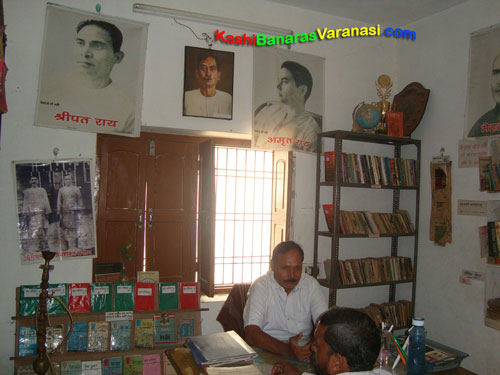
It is a beautiful picture of the Library of the Munshi Premchand which is located at his birthplace called, Lamhi village. The library has a collection of various photos of Shripat Rai, Amrit Rai, and Premchand, various medals, and books.

It is a clear picture of the collection of books in the library having photos of the Mehtay Rai on the walls. These books are written by the Premchand. This picture also has an amazing photo of the kite which was much liked and used by the Premchand.

This is the image of the library gate showing the picture of various stages of the Munshi Premchand as well as his great works.
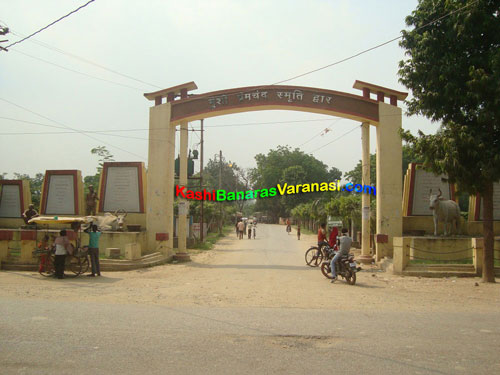
This is the Munshi Premchand Smriti Dwar, an entering gate to the Lamhi village from the main road. Both sides of the gate have pictures of a cow, men, and written marks.
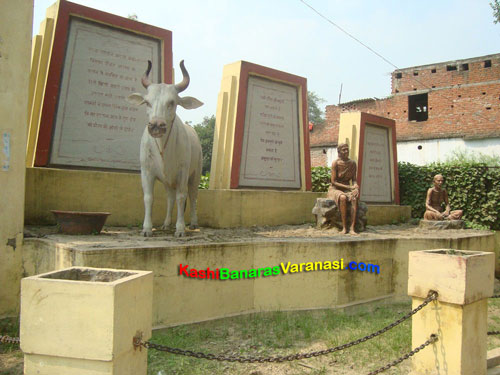
This is the picture taken to especially show the decoration of the gate, written marks, and culture of the time of Munshi Premchand.
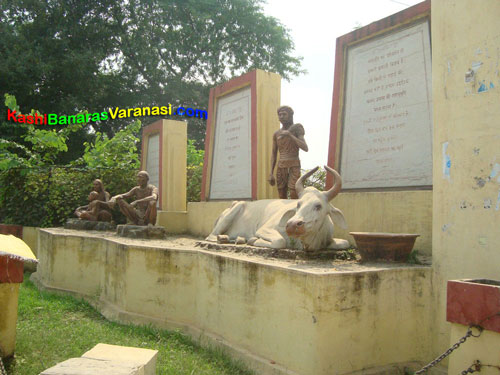
This is the picture showing the decorations of the gate of the Lamhi village.
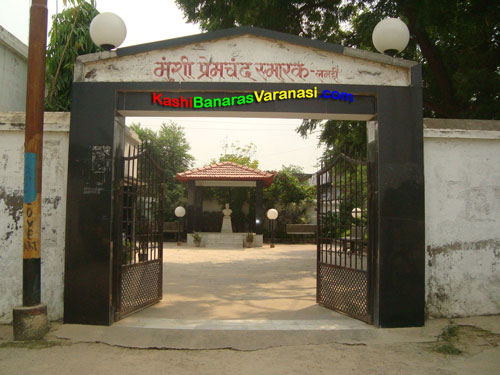
This is the main gate of the Memorial of the Munshi Premchand named Munshi Premchand Smarak, Lamhi.
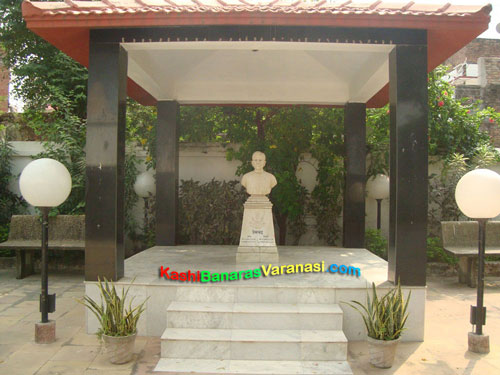
This is the picture of the inside view of the memorial of the Munshi Premchand showing the photo of the Munshi Premchand in the middle of the memorial.
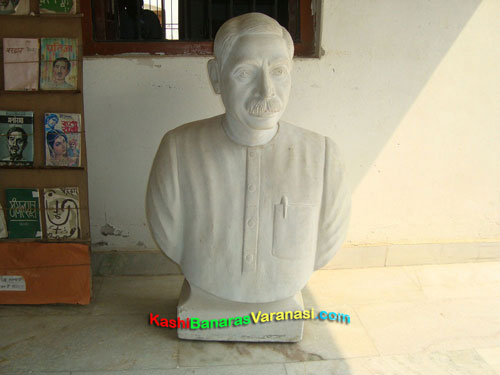
This is the image of the Munshi Premchand statue kept inside the memorial with the collection of various books.
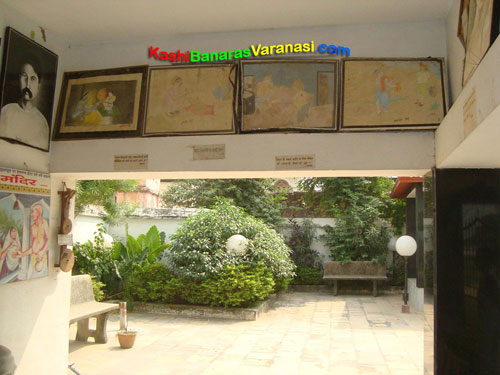
This is the picture showing the collection of paintings of the Munshi Premchand kept inside his memorial.

This is the picture showing the novel posters written by Munshi Premchand and kept in his memorial.

This is the picture showing the books posters written by the Munshi Premchand and kept inside the memorial.

This is the picture of the paintings by Munshi Premchand demonstrating his novels stories.
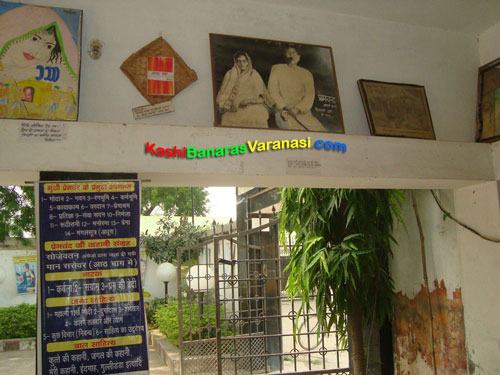
This is the picture showing the photograph of the Munshi Premchand and his wife kept inside his memorial.
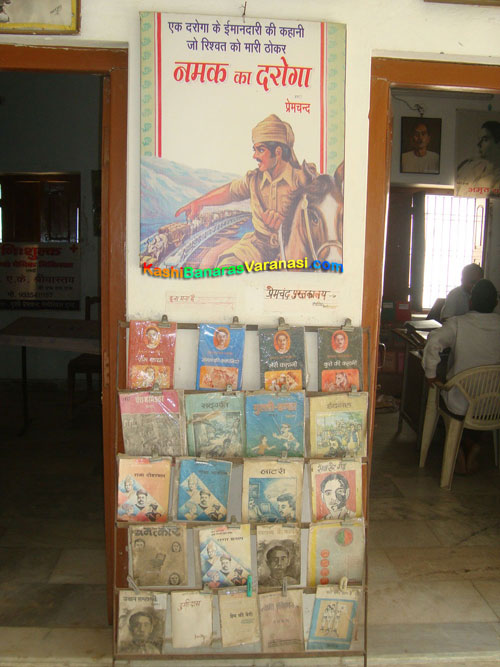
This is the picture showing the posters of his great writing “Namak Ka Daroga”.

This is the picture of the two storey house build by Munshi Premchand.
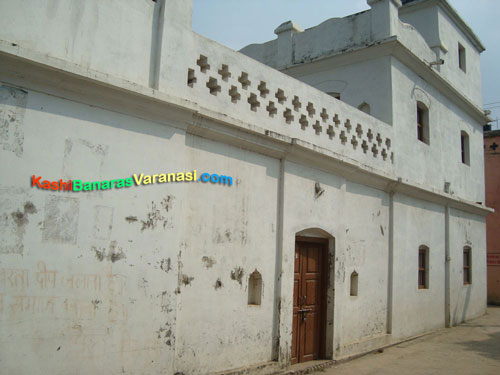
This is the close-up view of the home of Munshi Premchand.
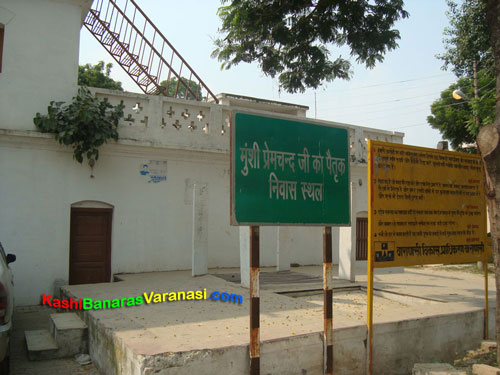
This is the photo of birthplace of Munshi Premchand and his paternal living place.
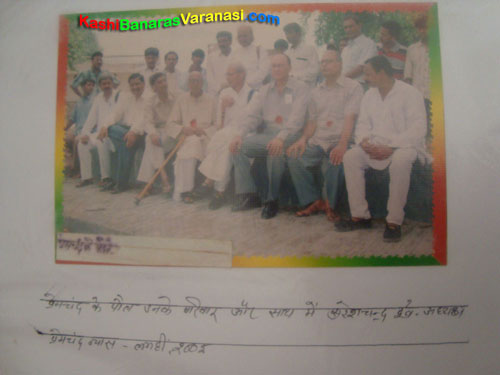
This is the image showing the descendants of him with Adhyaksh, Sureshchandra Dube.

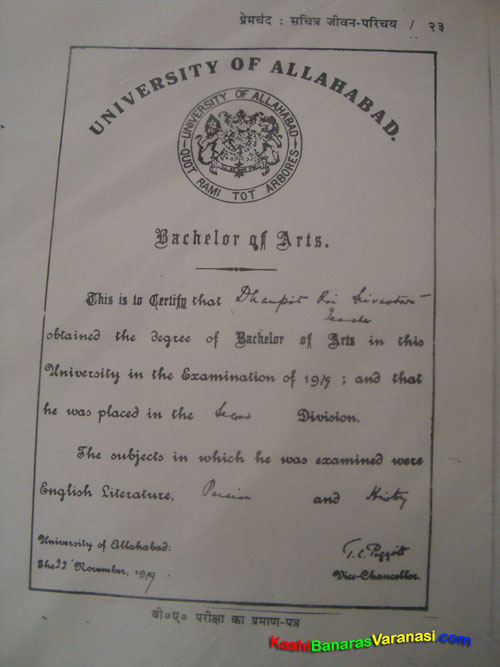
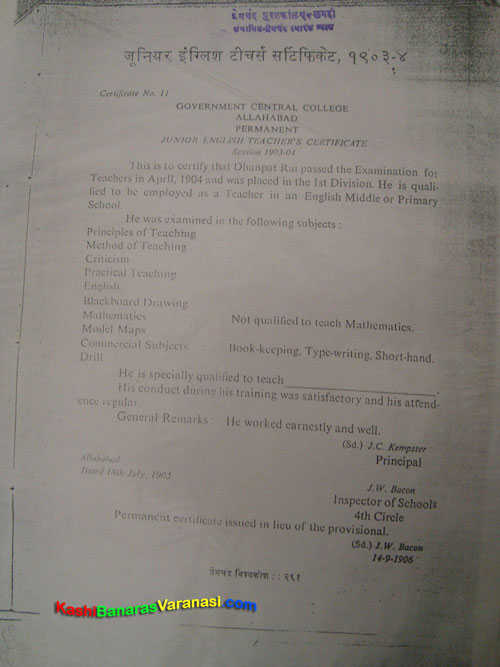
Scan Copy of His academic and professional documents
This is the Intermediate certificate of the Munshi Premchand passed out from the “University of Allahabad” in 1916.
This is the certificate of Munshi Premchand of Bachelor degree of Arts passed out from the “University of Allahabad” in 1919.
This is the Junior English Teachers Certificate of Munshi Premchand of Government Central College Allahabad.

This is the image showing the Niyukti Patra of the job of Munshi Premchand.
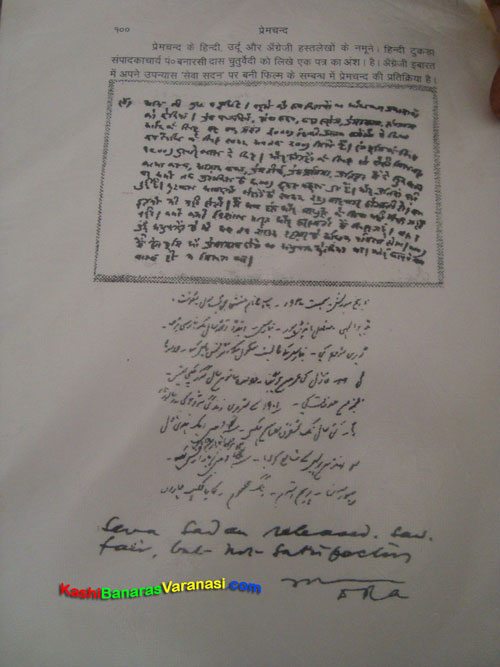
This is the picture showing the handwritten samples of his writings in many languages like Hindi, Urdu, and English.
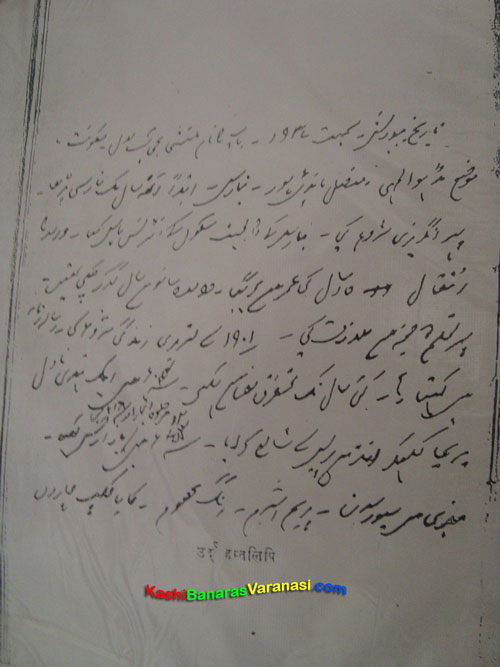
This is the picture of his Urdu handwritten samples of his great writings collected in the library.

This is the picture of his Hindi handwritten samples of his great writings collected in the library.

This is the picture of his English handwritten samples of his great writings collected in the library.

This is the Entrance Certificate of Munshi Premchand from the University of Allahabad in 1899.

This is the picture showing his job details means the time of joining and his promotions.
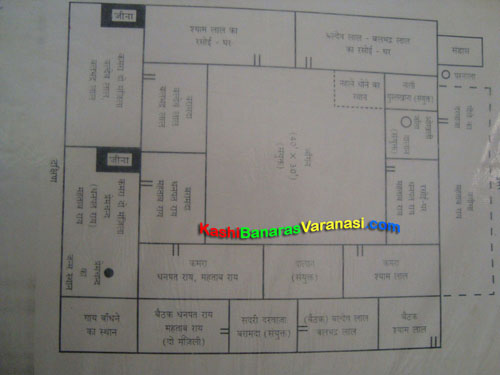
This is the real map of the home of the Munshi Premchand collected in his library.
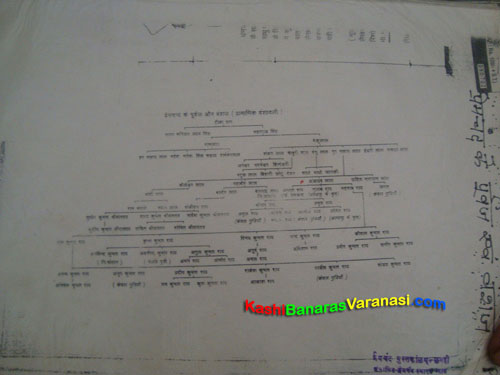
This is the picture showing the graphical representation of the descendants of the Munshi Premchand.
Related Information
Some Frequently Asked Questions
Ans. Dhanpat Rai was his real name but he used Nawab Rai as his pen name which he further changed to Munshi Premchand.
Ans. Godaan, Nirmala, Kafan, Pus ki Raat, Do bailo ki Katha, etc. are some of his best works.
Ans. His first major work was Seva Sadan that was published in the year 1919.
Ans. Premchand wrote more than 300 short stories, plays, many letters, translations, 14 novels, etc. Many of his plays and stories have been translated to various foreign languages posthumously.
Ans. He started his job on 18 rupees which was further promoted to 20 rupees.
Ans. Munshi Premchand was a well-known writer from India. He has never been anywhere outside India, which is different from many other writers. Premchand has written about 300 short stories, a few books, and many essays, letters, plays, and other types of writing.
Ans. Godaan (The Gift of a Cow, 1936), was Premchand’s last finished novel and is usually thought to be his best and one of the best Hindi novels.
Ans. Premchand struggled to make money his whole life. He once borrowed two and a half rupees so he could buy some clothes. It took him three years of hard work to pay it back.
Ans. Some of Premchand’s famous works are Premashram, Rangabhumi, Ghaban, Karmabhumi, and Godan.
Ans. Godan is the most famous story of Munshi Premchand
Ans. The moral of the story “The Child” gives people a new sense of how they fit into society.
Ans. His writings went beyond borders because he wrote about humor, romance, gender and social identity, and social inequality.
Ans. Premchand was a pioneer in both Urdu and Hindi social fiction. He was one of the first writers to talk about the caste system and the hard lives of women and workers in the late 1880s.
Ans. Premchand was never given a prize. But he had gotten a few honors. He was chosen to be the first President of the Progressive Writers’ Association, Lucknow.
Ans. Munshi Premchand didn’t write poems, but he wrote a lot of short stories and novels and was a well-known and respected figure in Indian writing.
Ans. Gandhi influenced Premchand, and after the author went to a meeting in Gorakhpur where Gandhi asked people to quit their government jobs, the author quit his job as a Deputy Inspector of Schools in Allahabad.
Ans. Munshi Premchand wrote about fourteen novels.
Ans. He used writing to bring attention to national and social problems. Like corruption, child widowhood, the colonial rule, prostitution, poverty, and Indian freedom struggle in his writings.
Ans. The five famous books of Premchand are Godan, Gaban, Nirmala, Kafan, Karmbhumi.
